
Illustrative Math Alignment: Grade 7 Unit 7
Expressions, Equations, and Inequalities
Lesson 9: Dealing with Negative Numbers
Use the following Media4Math resources with this Illustrative Math lesson.
| Thumbnail Image | Title | Body | Curriculum Topic |
|---|---|---|---|
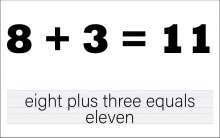
|
Math Clip Art--The Language of Math--Numbers and Equations 08 | Math Clip Art--The Language of Math--Numbers and Equations 08TopicThe Language of Math DescriptionThis image presents the equation "8+3=11" in both numerical and word form, advancing the complexity of addition concepts by introducing a sum greater than 10. The dual representation of the equation reinforces the connection between mathematical symbols and their verbal expressions. This visual aid is crucial in developing number sense and understanding the concept of addition, particularly how combining single-digit numbers can result in double-digit sums. |
Numerical Expressions |
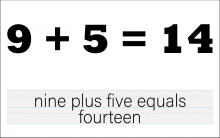
|
Math Clip Art--The Language of Math--Numbers and Equations 09 | Math Clip Art--The Language of Math--Numbers and Equations 09TopicThe Language of Math DescriptionThis clip art from the Language of Math collection illustrates the equation "9+5=14" in both numerical and word form. It continues the progression of addition concepts, now introducing a larger sum and the concept of adding a single-digit number to 9. The dual representation of the equation helps students connect the abstract mathematical symbols with their concrete verbal expressions. This visual aid is crucial in developing number sense and understanding the concept of addition, particularly how combining numbers can result in sums greater than 10. |
Numerical Expressions |
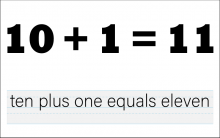
|
Math Clip Art--The Language of Math--Numbers and Equations 10 | Math Clip Art--The Language of Math--Numbers and Equations 10TopicThe Language of Math DescriptionThis image from the Language of Math collection presents the equation "10+1=11" in both numerical and word form. It marks a significant transition in the addition sequence, introducing the concept of adding to a double-digit number. The dual representation of the equation reinforces the connection between mathematical symbols and their verbal expressions. This visual aid is crucial in developing number sense and understanding the concept of addition, particularly how adding to 10 results in the next consecutive number. |
Numerical Expressions |
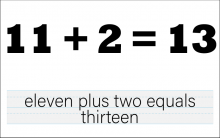
|
Math Clip Art--The Language of Math--Numbers and Equations 11 | Math Clip Art--The Language of Math--Numbers and Equations 11TopicThe Language of Math DescriptionThis image from the Language of Math collection illustrates the equation "11+2=13" in both numerical and word form. It advances the complexity of addition concepts by introducing larger numbers and sums exceeding 10. The dual representation of the equation reinforces the connection between mathematical symbols and their verbal expressions. This visual aid is crucial in developing number sense and understanding the concept of addition, particularly how combining numbers results in sums greater than 10. |
Numerical Expressions |
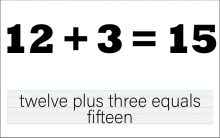
|
Math Clip Art--The Language of Math--Numbers and Equations 12 | Math Clip Art--The Language of Math--Numbers and Equations 12TopicThe Language of Math DescriptionThis clip art from the Language of Math collection showcases the equation "12+3=15" in both numerical and word formats. It continues the progression of addition concepts with larger numbers and sums. The simultaneous presentation of the equation in symbols and words reinforces the connection between mathematical language and everyday language. This visual representation helps students understand how numbers combine and introduces the concept of adding to a number greater than 10. |
Numerical Expressions |

|
Math Clip Art--The Language of Math--Numbers and Equations 13 | Math Clip Art--The Language of Math--Numbers and Equations 13TopicThe Language of Math DescriptionThis image from the Language of Math series presents the equation "13+4=17" in both numerical and word form. It continues the progression of addition concepts with increasingly larger numbers and sums. The dual representation of the equation helps students connect the abstract mathematical symbols with their concrete verbal expressions. This visual aid is crucial in developing number sense and understanding the concept of addition, particularly how combining teen numbers with single-digit numbers results in larger sums. |
Numerical Expressions |
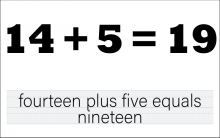
|
Math Clip Art--The Language of Math--Numbers and Equations 14 | Math Clip Art--The Language of Math--Numbers and Equations 14TopicThe Language of Math DescriptionThis clip art from the Language of Math collection illustrates the equation "14+5=19" in both numerical and word form. It advances the complexity of addition concepts by working with larger teen numbers and approaching sums close to 20. The simultaneous presentation of the equation in symbols and words strengthens the connection between mathematical language and everyday language. This visual representation helps students understand how numbers combine and introduces the concept of adding to a number in the teens. |
Numerical Expressions |
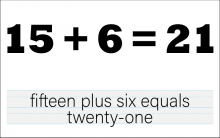
|
Math Clip Art--The Language of Math--Numbers and Equations 15 | Math Clip Art--The Language of Math--Numbers and Equations 15TopicThe Language of Math DescriptionThis image from the Language of Math series depicts the equation "15+6=21" in both numerical and word form. It continues the progression of addition concepts, now introducing sums that exceed 20. The dual representation of the equation reinforces the connection between mathematical symbols and their verbal expressions. This visual aid is crucial in developing number sense and understanding the concept of addition, particularly how combining teen numbers with single-digit numbers can result in sums greater than 20. |
Numerical Expressions |
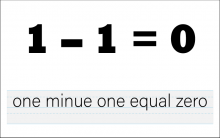
|
Math Clip Art--The Language of Math--Numbers and Equations 16 | Math Clip Art--The Language of Math--Numbers and Equations 16TopicThe Language of Math DescriptionThis clip art from the Language of Math collection illustrates the equation "1-1=0" in both numerical and word form. It introduces the concept of subtraction and the idea of a difference of zero. The simultaneous presentation of the equation in symbols and words reinforces the connection between mathematical language and everyday language. This visual representation helps students understand the basic concept of subtraction and introduces the idea that subtracting a number from itself results in zero. |
Numerical Expressions |

|
Math Clip Art--The Language of Math--Numbers and Equations 17 | Math Clip Art--The Language of Math--Numbers and Equations 17TopicThe Language of Math DescriptionThis image from the Language of Math series presents the equation "2-1=1" in both numerical and word form. It continues the introduction of subtraction concepts, now showing a non-zero difference. The dual representation of the equation reinforces the connection between mathematical symbols and their verbal expressions. This visual aid is crucial in developing number sense and understanding the concept of subtraction, particularly how removing one from a quantity results in a smaller number. |
Numerical Expressions |
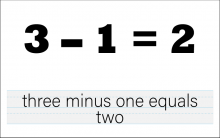
|
Math Clip Art--The Language of Math--Numbers and Equations 18 | Math Clip Art--The Language of Math--Numbers and Equations 18TopicThe Language of Math DescriptionThis image presents the equation "3-1=2" in both numerical and word form. It continues the progression of subtraction concepts, now working with a larger minuend. The simultaneous presentation of the equation in symbols and words strengthens the connection between mathematical language and everyday language. This visual representation helps students understand how subtraction works and introduces the concept of "one less than" a given number. |
Numerical Expressions |
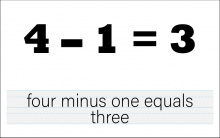
|
Math Clip Art--The Language of Math--Numbers and Equations 19 | Math Clip Art--The Language of Math--Numbers and Equations 19TopicThe Language of Math DescriptionThis image illustrates the equation "4-1=3" in both numerical and word form. It continues the progression of subtraction concepts, now working with a larger minuend. The dual representation of the equation reinforces the connection between mathematical symbols and their verbal expressions. This visual aid is crucial in developing number sense and understanding the concept of subtraction, particularly how removing one from a quantity results in a smaller number. |
Numerical Expressions |
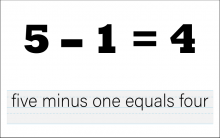
|
Math Clip Art--The Language of Math--Numbers and Equations 20 | Math Clip Art--The Language of Math--Numbers and Equations 20TopicThe Language of Math DescriptionThis clip art from the Language of Math collection showcases the equation "5-1=4" in both numerical and word formats. It continues the series of subtraction equations, now introducing a larger minuend. The simultaneous presentation of the equation in symbols and words reinforces the connection between mathematical language and everyday language. This visual representation helps students understand how subtraction works and introduces the concept of "one less than" a given number. |
Numerical Expressions |
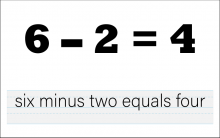
|
Math Clip Art--The Language of Math--Numbers and Equations 21 | Math Clip Art--The Language of Math--Numbers and Equations 21TopicThe Language of Math DescriptionThis image presents the equation "6-2=4" in both numerical and word form. It advances the complexity of subtraction concepts by introducing a subtrahend greater than 1. The dual representation of the equation reinforces the connection between mathematical symbols and their verbal expressions. This visual aid is crucial in developing number sense and understanding the concept of subtraction, particularly how removing multiple units from a quantity affects the result. |
Numerical Expressions |
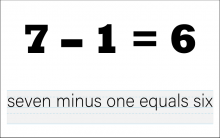
|
Math Clip Art--The Language of Math--Numbers and Equations 22 | Math Clip Art--The Language of Math--Numbers and Equations 22TopicThe Language of Math DescriptionThis clip art from the Language of Math collection illustrates the equation "7-1=6" in both numerical and word form. It continues the progression of subtraction concepts, now working with a larger minuend. The simultaneous presentation of the equation in symbols and words strengthens the connection between mathematical language and everyday language. This visual representation helps students understand how subtraction works and reinforces the concept of "one less than" a given number. |
Numerical Expressions |
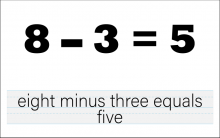
|
Math Clip Art--The Language of Math--Numbers and Equations 23 | Math Clip Art--The Language of Math--Numbers and Equations 23TopicThe Language of Math DescriptionThis image presents the equation "8-3=5" in both numerical and word form. It advances the complexity of subtraction concepts by introducing a larger subtrahend and working with single-digit numbers. The dual representation of the equation reinforces the connection between mathematical symbols and their verbal expressions. This visual aid is crucial in developing number sense and understanding the concept of subtraction, particularly how removing multiple units from a quantity affects the result. |
Numerical Expressions |
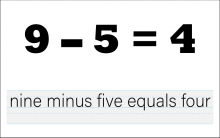
|
Math Clip Art--The Language of Math--Numbers and Equations 24 | Math Clip Art--The Language of Math--Numbers and Equations 24TopicThe Language of Math DescriptionThis clip art from the Language of Math collection showcases the equation "9-5=4" in both numerical and word formats. It continues the progression of subtraction concepts, now introducing a larger subtrahend and working with single-digit numbers. The simultaneous presentation of the equation in symbols and words reinforces the connection between mathematical language and everyday language. This visual representation helps students understand how subtraction works with larger numbers and introduces the concept of "finding the difference" between two numbers. |
Numerical Expressions |
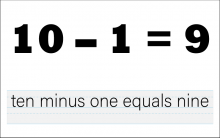
|
Math Clip Art--The Language of Math--Numbers and Equations 25 | Math Clip Art--The Language of Math--Numbers and Equations 25TopicThe Language of Math DescriptionThis image illustrates the equation "10-1=9" in both numerical and word form. It introduces subtraction with a two-digit number, marking a significant step in mathematical understanding. The dual representation of the equation reinforces the connection between mathematical symbols and their verbal expressions. This visual aid is crucial in developing number sense and understanding the concept of subtraction, particularly how removing one from a round number results in a single-digit answer. |
Numerical Expressions |

|
Math Clip Art--The Language of Math--Numbers and Equations 26 | Math Clip Art--The Language of Math--Numbers and Equations 26TopicThe Language of Math DescriptionThis clip art from the Language of Math collection showcases the equation "11-2=9" in both numerical and word formats. It continues the progression of subtraction concepts, now working with larger two-digit numbers. The simultaneous presentation of the equation in symbols and words reinforces the connection between mathematical language and everyday language. This visual representation helps students understand how subtraction works with larger numbers and introduces the concept of "finding the difference" between two numbers. |
Numerical Expressions |
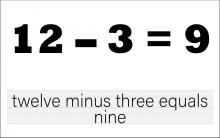
|
Math Clip Art--The Language of Math--Numbers and Equations 27 | Math Clip Art--The Language of Math--Numbers and Equations 27TopicThe Language of Math DescriptionThis image presents the equation "12-3=9" in both numerical and word form. It advances the complexity of subtraction concepts by introducing larger two-digit numbers and a subtrahend greater than 1. The dual representation of the equation reinforces the connection between mathematical symbols and their verbal expressions. This visual aid is crucial in developing number sense and understanding the concept of subtraction, particularly how removing multiple units from a quantity affects the result. |
Numerical Expressions |
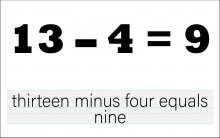
|
Math Clip Art--The Language of Math--Numbers and Equations 28 | Math Clip Art--The Language of Math--Numbers and Equations 28TopicThe Language of Math DescriptionThis clip art from the Language of Math collection illustrates the equation "13-4=9" in both numerical and word form. It continues the progression of subtraction concepts, now working with larger two-digit numbers and a subtrahend greater than 3. The simultaneous presentation of the equation in symbols and words strengthens the connection between mathematical language and everyday language. This visual representation helps students understand how subtraction works with larger numbers and reinforces the concept of "finding the difference" between two numbers. |
Numerical Expressions |
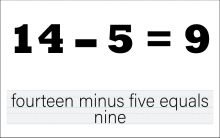
|
Math Clip Art--The Language of Math--Numbers and Equations 29 | Math Clip Art--The Language of Math--Numbers and Equations 29TopicThe Language of Math DescriptionThis image presents the equation "14-5=9" in both numerical and word form. It advances the complexity of subtraction concepts by introducing larger two-digit numbers and a subtrahend of 5. The dual representation of the equation reinforces the connection between mathematical symbols and their verbal expressions. This visual aid is crucial in developing number sense and understanding the concept of subtraction, particularly how removing half of 10 from a teen number results in a single-digit answer. |
Numerical Expressions |
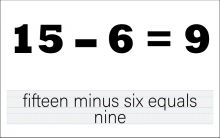
|
Math Clip Art--The Language of Math--Numbers and Equations 30 | Math Clip Art--The Language of Math--Numbers and Equations 30TopicThe Language of Math DescriptionThis clip art from the Language of Math collection showcases the equation "15-6=9" in both numerical and word formats. It continues the progression of subtraction concepts, now working with larger two-digit numbers and a subtrahend greater than 5. |
Numerical Expressions |

|
Math Clip Art--The Language of Math--Numbers and Equations 31 | Math Clip Art--The Language of Math--Numbers and Equations 31TopicThe Language of Math DescriptionThis image illustrates the equation "1*1=1" in both numerical and word form. It introduces the concept of multiplication, starting with the simplest case of multiplying 1 by itself. The dual representation of the equation reinforces the connection between mathematical symbols and their verbal expressions. This visual aid is crucial in developing number sense and understanding the concept of multiplication as repeated addition. |
Numerical Expressions |
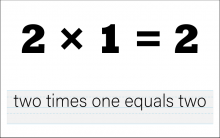
|
Math Clip Art--The Language of Math--Numbers and Equations 32 | Math Clip Art--The Language of Math--Numbers and Equations 32TopicThe Language of Math DescriptionThis clip art from the Language of Math collection showcases the equation "2*1=2" in both numerical and word formats. It continues the introduction of multiplication concepts, now showing multiplication by 1. The simultaneous presentation of the equation in symbols and words reinforces the connection between mathematical language and everyday language. This visual representation helps students understand how multiplication works and introduces the concept of the identity property of multiplication. |
Numerical Expressions |
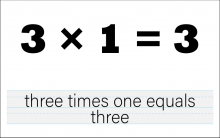
|
Math Clip Art--The Language of Math--Numbers and Equations 33 | Math Clip Art--The Language of Math--Numbers and Equations 33TopicThe Language of Math DescriptionThis image presents the equation "3*1=3" in both numerical and word form. It continues the progression of multiplication concepts, focusing on the multiplication of a single-digit number by 1. The dual representation of the equation reinforces the connection between mathematical symbols and their verbal expressions. This visual aid is crucial in developing number sense and understanding the concept of multiplication, particularly how multiplying by 1 results in the same number. |
Numerical Expressions |

|
Math Clip Art--The Language of Math--Numbers and Equations 34 | Math Clip Art--The Language of Math--Numbers and Equations 34TopicThe Language of Math DescriptionThis clip art from the Language of Math collection illustrates the equation "4*1=4" in both numerical and word form. It continues the progression of multiplication concepts, focusing on the multiplication of a single-digit number by 1. The simultaneous presentation of the equation in symbols and words strengthens the connection between mathematical language and everyday language. This visual representation helps students understand how multiplication works and reinforces the concept of the identity property of multiplication. |
Numerical Expressions |
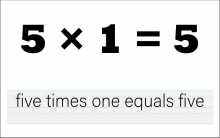
|
Math Clip Art--The Language of Math--Numbers and Equations 35 | Math Clip Art--The Language of Math--Numbers and Equations 35TopicThe Language of Math DescriptionThis image presents the equation "5*1=5" in both numerical and word form. It continues the progression of multiplication concepts, focusing on the multiplication of a single-digit number by 1. The dual representation of the equation reinforces the connection between mathematical symbols and their verbal expressions. This visual aid is crucial in developing number sense and understanding the concept of multiplication, particularly how multiplying by 1 results in the same number. |
Numerical Expressions |

|
Math Clip Art--The Language of Math--Numbers and Equations 36 | Math Clip Art--The Language of Math--Numbers and Equations 36TopicThe Language of Math DescriptionThis clip art from the Language of Math collection showcases the equation "6*2=12" in both numerical and word formats. It advances the complexity of multiplication concepts by introducing multiplication by a number other than 1. The simultaneous presentation of the equation in symbols and words reinforces the connection between mathematical language and everyday language. This visual representation helps students understand how multiplication works with larger numbers and introduces the concept of repeated addition. |
Numerical Expressions |
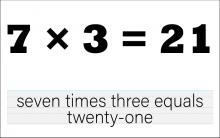
|
Math Clip Art--The Language of Math--Numbers and Equations 37 | Math Clip Art--The Language of Math--Numbers and Equations 37TopicThe Language of Math DescriptionThis image presents the equation "7*3=21" in both numerical and word form. It continues the progression of multiplication concepts, now introducing multiplication with larger single-digit numbers. The dual representation of the equation reinforces the connection between mathematical symbols and their verbal expressions. This visual aid is crucial in developing number sense and understanding the concept of multiplication, particularly how it relates to repeated addition and grouping. |
Numerical Expressions |
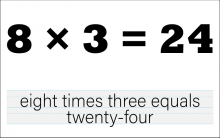
|
Math Clip Art--The Language of Math--Numbers and Equations 38 | Math Clip Art--The Language of Math--Numbers and Equations 38TopicThe Language of Math DescriptionThis clip art from the Language of Math collection illustrates the equation "8*3=24" in both numerical and word form. It continues the progression of multiplication concepts, focusing on multiplication with larger single-digit numbers. The simultaneous presentation of the equation in symbols and words strengthens the connection between mathematical language and everyday language. This visual representation helps students understand how multiplication works with larger numbers and reinforces the concept of repeated addition and grouping. |
Numerical Expressions |
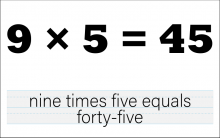
|
Math Clip Art--The Language of Math--Numbers and Equations 39 | Math Clip Art--The Language of Math--Numbers and Equations 39TopicThe Language of Math DescriptionThis image presents the equation "9*5=45" in both numerical and word form. It advances the complexity of multiplication concepts by introducing larger single-digit numbers and a product greater than 40. The dual representation of the equation reinforces the connection between mathematical symbols and their verbal expressions. This visual aid is crucial in developing number sense and understanding the concept of multiplication, particularly how it relates to repeated addition and grouping with larger numbers. |
Numerical Expressions |

|
Math Clip Art--The Language of Math--Numbers and Equations 40 | Math Clip Art--The Language of Math--Numbers and Equations 40TopicThe Language of Math DescriptionThis clip art from the Language of Math collection illustrates the equation "10*2=20" in both numerical and word form. It introduces multiplication with a two-digit number, marking a significant step in mathematical understanding. The simultaneous presentation of the equation in symbols and words strengthens the connection between mathematical language and everyday language. This visual representation helps students understand how multiplication works with larger numbers and reinforces the concept of repeated addition and grouping. |
Numerical Expressions |
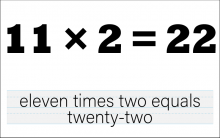
|
Math Clip Art--The Language of Math--Numbers and Equations 41 | Math Clip Art--The Language of Math--Numbers and Equations 41TopicThe Language of Math DescriptionThis image presents the equation "11*2=22" in both numerical and word form. It continues the progression of multiplication concepts, now working with two-digit numbers. The dual representation of the equation reinforces the connection between mathematical symbols and their verbal expressions. This visual aid is crucial in developing number sense and understanding the concept of multiplication, particularly how it relates to repeated addition and grouping with larger numbers. |
Numerical Expressions |

|
Math Clip Art--The Language of Math--Numbers and Equations 42 | Math Clip Art--The Language of Math--Numbers and Equations 42TopicThe Language of Math DescriptionThis clip art from the Language of Math collection illustrates the equation "12*3=36" in both numerical and word form. It advances the complexity of multiplication concepts by introducing larger two-digit numbers and a product greater than 30. The simultaneous presentation of the equation in symbols and words strengthens the connection between mathematical language and everyday language. This visual representation helps students understand how multiplication works with larger numbers and reinforces the concept of repeated addition and grouping. |
Numerical Expressions |
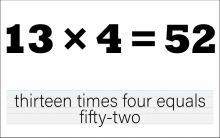
|
Math Clip Art--The Language of Math--Numbers and Equations 43 | Math Clip Art--The Language of Math--Numbers and Equations 43TopicThe Language of Math DescriptionThis image presents the equation "13*4=52" in both numerical and word form. It continues the progression of multiplication concepts, now working with larger two-digit numbers and a product greater than 50. The dual representation of the equation reinforces the connection between mathematical symbols and their verbal expressions. This visual aid is crucial in developing number sense and understanding the concept of multiplication, particularly how it relates to repeated addition and grouping with larger numbers. |
Numerical Expressions |
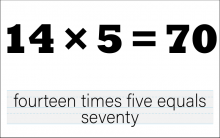
|
Math Clip Art--The Language of Math--Numbers and Equations 44 | Math Clip Art--The Language of Math--Numbers and Equations 44TopicThe Language of Math DescriptionThis clip art from the Language of Math collection illustrates the equation "14*5=70" in both numerical and word form. It advances the complexity of multiplication concepts by introducing larger two-digit numbers and a product reaching 70. The simultaneous presentation of the equation in symbols and words strengthens the connection between mathematical language and everyday language. This visual representation helps students understand how multiplication works with larger numbers and reinforces the concept of repeated addition and grouping. |
Numerical Expressions |
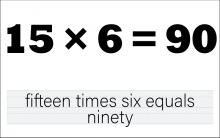
|
Math Clip Art--The Language of Math--Numbers and Equations 45 | Math Clip Art--The Language of Math--Numbers and Equations 45TopicThe Language of Math DescriptionThis image presents the equation "15*6=90" in both numerical and word form. It continues the progression of multiplication concepts, now working with larger two-digit numbers and a product reaching 90. The dual representation of the equation reinforces the connection between mathematical symbols and their verbal expressions. This visual aid is crucial in developing number sense and understanding the concept of multiplication, particularly how it relates to repeated addition and grouping with larger numbers. |
Numerical Expressions |

|
Math Clip Art--The Language of Math--Numbers and Equations 46 | Math Clip Art--The Language of Math--Numbers and Equations 46TopicThe Language of Math DescriptionThis clip art from the Language of Math collection illustrates the equation "1/1=1" in both numerical and word form. It introduces the concept of division, starting with the simplest case of dividing a number by itself. The simultaneous presentation of the equation in symbols and words strengthens the connection between mathematical language and everyday language. This visual representation helps students understand the basic concept of division and introduces the idea that any number divided by itself equals 1. |
Numerical Expressions |

|
Math Clip Art--The Language of Math--Numbers and Equations 47 | Math Clip Art--The Language of Math--Numbers and Equations 47TopicThe Language of Math DescriptionThis image presents the equation "2/2=1" in both numerical and word form. It continues the progression of division concepts, now working with a fraction where the numerator and denominator are equal. The dual representation of the equation reinforces the connection between mathematical symbols and their verbal expressions. This visual aid is crucial in developing number sense and understanding the concept of division, particularly how dividing a number by itself always results in 1. |
Numerical Expressions |

|
Math Clip Art--The Language of Math--Numbers and Equations 48 | Math Clip Art--The Language of Math--Numbers and Equations 48TopicThe Language of Math DescriptionThis clip art from the Language of Math collection illustrates the equation "3/3=1" in both numerical and word form. It continues the series of division concepts, focusing on fractions where the numerator and denominator are equal. The simultaneous presentation of the equation in symbols and words strengthens the connection between mathematical language and everyday language. This visual representation helps students understand how division works and reinforces the concept that any number divided by itself equals 1. |
Numerical Expressions |
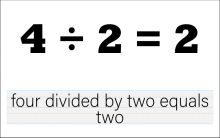
|
Math Clip Art--The Language of Math--Numbers and Equations 49 | Math Clip Art--The Language of Math--Numbers and Equations 49TopicThe Language of Math DescriptionThis image presents the equation "4/2=2" in both numerical and word form. It advances the complexity of division concepts by introducing a fraction where the numerator is greater than the denominator. The dual representation of the equation reinforces the connection between mathematical symbols and their verbal expressions. This visual aid is crucial in developing number sense and understanding the concept of division, particularly how dividing by a smaller number results in a larger quotient. |
Numerical Expressions |
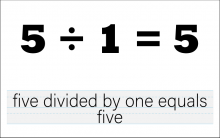
|
Math Clip Art--The Language of Math--Numbers and Equations 50 | Math Clip Art--The Language of Math--Numbers and Equations 50TopicThe Language of Math DescriptionThis clip art from the Language of Math collection illustrates the equation "5/1=5" in both numerical and word form. It introduces the concept of dividing by 1, which is a fundamental principle in mathematics. The simultaneous presentation of the equation in symbols and words strengthens the connection between mathematical language and everyday language. This visual representation helps students understand that dividing a number by 1 results in the same number, reinforcing the identity property of division. |
Numerical Expressions |
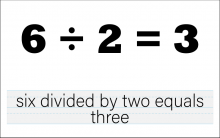
|
Math Clip Art--The Language of Math--Numbers and Equations 51 | Math Clip Art--The Language of Math--Numbers and Equations 51TopicThe Language of Math DescriptionThis image presents the equation "6/2=3" in both numerical and word form. It continues the progression of division concepts, now working with larger numbers and introducing the concept of halving. The dual representation of the equation reinforces the connection between mathematical symbols and their verbal expressions. This visual aid is crucial in developing number sense and understanding the concept of division, particularly how dividing by 2 relates to finding half of a number. |
Numerical Expressions |
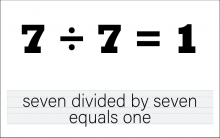
|
Math Clip Art--The Language of Math--Numbers and Equations 52 | Math Clip Art--The Language of Math--Numbers and Equations 52TopicThe Language of Math DescriptionThis clip art from the Language of Math collection illustrates the equation "7/7=1" in both numerical and word form. It reinforces the concept that any number divided by itself equals 1. The simultaneous presentation of the equation in symbols and words strengthens the connection between mathematical language and everyday language. This visual representation helps students understand a fundamental principle of division and introduces the concept of equivalent fractions. |
Numerical Expressions |
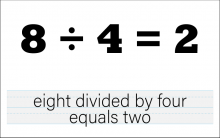
|
Math Clip Art--The Language of Math--Numbers and Equations 53 | Math Clip Art--The Language of Math--Numbers and Equations 53TopicThe Language of Math DescriptionThis image presents the equation "8/4=2" in both numerical and word form. It advances the complexity of division concepts by introducing division with larger numbers and the concept of quartering. The dual representation of the equation reinforces the connection between mathematical symbols and their verbal expressions. This visual aid is crucial in developing number sense and understanding the concept of division, particularly how dividing by 4 relates to finding a quarter of a number. |
Numerical Expressions |
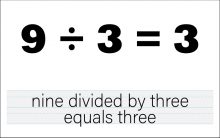
|
Math Clip Art--The Language of Math--Numbers and Equations 54 | Math Clip Art--The Language of Math--Numbers and Equations 54TopicThe Language of Math DescriptionThis clip art from the Language of Math collection illustrates the equation "9/3=3" in both numerical and word form. It continues the progression of division concepts, now working with larger numbers and introducing the concept of thirds. The simultaneous presentation of the equation in symbols and words strengthens the connection between mathematical language and everyday language. This visual representation helps students understand how division works with larger numbers and reinforces the concept of equal sharing. |
Numerical Expressions |
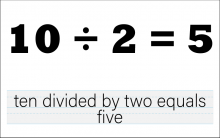
|
Math Clip Art--The Language of Math--Numbers and Equations 55 | Math Clip Art--The Language of Math--Numbers and Equations 55TopicThe Language of Math DescriptionThis image presents the equation "10/2=5" in both numerical and word form. It continues the progression of division concepts, now working with larger numbers and reinforcing the concept of halving. The dual representation of the equation reinforces the connection between mathematical symbols and their verbal expressions. This visual aid is crucial in developing number sense and understanding the concept of division, particularly how dividing by 2 relates to finding half of a number, even with larger values. |
Numerical Expressions |
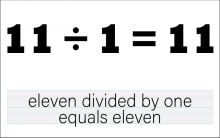
|
Math Clip Art--The Language of Math--Numbers and Equations 56 | Math Clip Art--The Language of Math--Numbers and Equations 56TopicThe Language of Math DescriptionThis clip art from the Language of Math collection illustrates the equation "11/1=11" in both numerical and word form. It introduces the concept of dividing by 1, which is a fundamental principle in mathematics. The simultaneous presentation of the equation in symbols and words strengthens the connection between mathematical language and everyday language. This visual representation helps students understand that dividing a number by 1 results in the same number, reinforcing the identity property of division. |
Numerical Expressions |
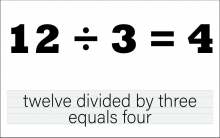
|
Math Clip Art--The Language of Math--Numbers and Equations 57 | Math Clip Art--The Language of Math--Numbers and Equations 57TopicThe Language of Math DescriptionThis image presents the equation "12/3=4" in both numerical and word form. It advances the complexity of division concepts by working with larger numbers and introducing the concept of dividing by 3. The dual representation of the equation reinforces the connection between mathematical symbols and their verbal expressions. This visual aid is crucial in developing number sense and understanding the concept of division, particularly how dividing by 3 relates to grouping numbers into thirds. |
Numerical Expressions |